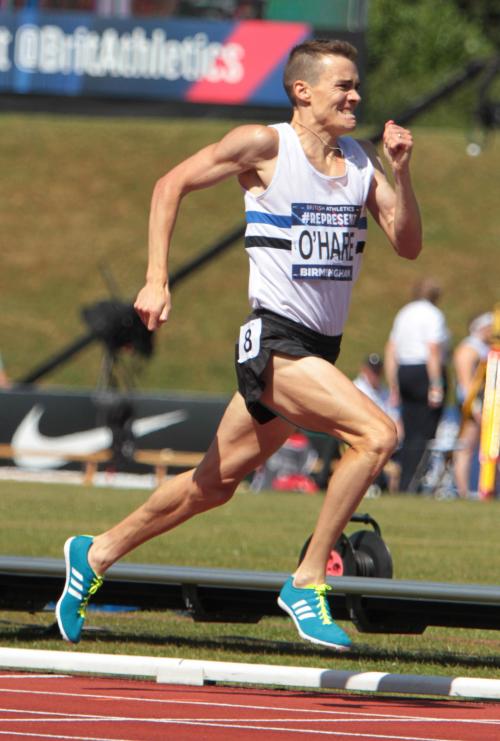 Chris O’Hare winning British Trials, photo by David Wearn
Chris O’Hare winning British Trials, photo by David Wearn
RunBlogRun opines: This is the weekly column from Paul Halford on British athletics. Paul Halford is a longtime runner and observer of the sport, having written for Athletics Weekly, among other media groups. This week, Paul spoke with Chris O’Hare and opines on the Diamond League.
The World Championships final may not have gone anywhere near as well as he’d hoped, but Chris O’Hare is optimistic for himself and British middle-distance running at a time when he says the playing field is more level due to better drugs testing.
The Tulsa University alumni had been considered a medal contender in an open London 2017 final but ended up 12th.
However, as Norway’s Filip Ingebrigtsen – with a PB of 3:42.48 – showed in winning bronze in London, O’Hare knows he is in the ballpark for medals in future.
“I think basically the testing’s working,” said the Scot. “It’s making it more of a level playing field and that’s good.”
He is confident also for the state of 800m and 1500m in his home country, which ruled the world in the early 1980s with the likes of Seb Coe, Steve Ovett and Steve Cram, but which has struggled in most periods since. A week on from the London final, he was beaten at the Emsley Carr Mile in Birmingham by Jake Wightman, who became the first Brit to win the historic race since 2005.
The pair had been split by 19-year-old Josh Kerr, an eventual Worlds representative, at the British Championships in a race O’Hare believes bodes well for the future.
“I think the trials this year were a testament to how good [British] 1500m running is,” said the winner on that day. “Charlie (Grice, PB 3:36.60) is an Olympic finalist, a World finalist and he didn’t make the [Worlds] team.So that just shows you how tough it is and that’s going to bring us all on for sure and that’s exciting.”
The man who clocked a PB of 3:33.61 in finishing seventh in Monaco this year feels he was only “95% on” in the Worlds final and also feels he let himself down tactically.
“In a race like that you’ve got to 100% play to your strengths and I’m not sure I did,” he said.
As for his race in Birmingham, he added: “I felt terrible today. I’m just exhausted. Today was more just about making sure I didn’t do anything silly and thinking keep going and going and see what you can do on the last lap. It was a long race. Sometimes a mile feels short but today it felt long. We got to 800m and I thought, ‘I’m exhausted’, so I’m happy to come away with second and I’m happy that Jake won it instead of someone else.”
O’Hare will end his season on the US road running circuit, including running the Fifth Avenue Mile in New York.
“They’re good fun,” he said of the end-of-season road miles. “It’s surrounded by good friends and it’s a good laugh. That kind of takes away the pressure of racing and you go there and have fun and that’s what I’m looking for at the moment.”
—–
The Birmingham meeting last Sunday I believe confirmed the Diamond League to be too much of a good thing – at least from the point of view of we afficianados. Back in the 1980s when I got into athletics, I watched meetings like Zurich in awe. It was “the Olympics in one night”, the biggest one-day meeting by far.
It became one of the “Golden Four” along with Oslo, Brussels and Berlin and that gave way to the Golden League of six meetings. The IAAF then decided to try bottle the magic of these meetings and expand it so the Golden League became eight venues before the making it even bigger as the Diamond League, which is now 14-strong.
It has unfortunately diluted the brand in my opinion. Admittedly, each meeting only carries half of the disciplines, but some of them can fall a little flat due to there not being enough top athletes to go around.
This week I will realise a lifetime ambition by attending “the Weltklasse” in Zurich, but – and perhaps it’s simply a case of the remembering “the good old days” – it won’t feel as good as it would have done in the 1980s and 1990s. Zurich is now just one of the 14. It’s a final but, rather confusingly for the general public, it’s not the only final.
More often than not, Zurich would take place before the major championships just as athletes were hitting their peaks. Nowadays, it and the other final, Brussels, tend to come after. Some athletes have ended their seasons – some in body and some in mind – as a long, hard season takes its toll. I hope I’m proved wrong.
Birmingham looked on paper as though it should have been a great meeting. With several athletes hanging around after the Worlds in the same country, the startlists boasted more than 50 London medallist. That is why all-athletics.com rated it the second best on “participation score” of all the one-day meetings this year. However, the results didn’t come up to scratch and all-athletics.com‘s rankings placed it 10th on “performance score”. Mutaz Barshim, with his 2.40m high jump, came to the rescue at the end of the meeting of those in need of a great performance on which to hang a headline.
However, I must recognise that what’s best for the aficionado and best for selling the most tickets over an entire season are not the same thing. It was great to see thousands of spectators at Birmingham – athletics needs more aficionados and let’s hope some of them will come from last Sunday’s audience.






















